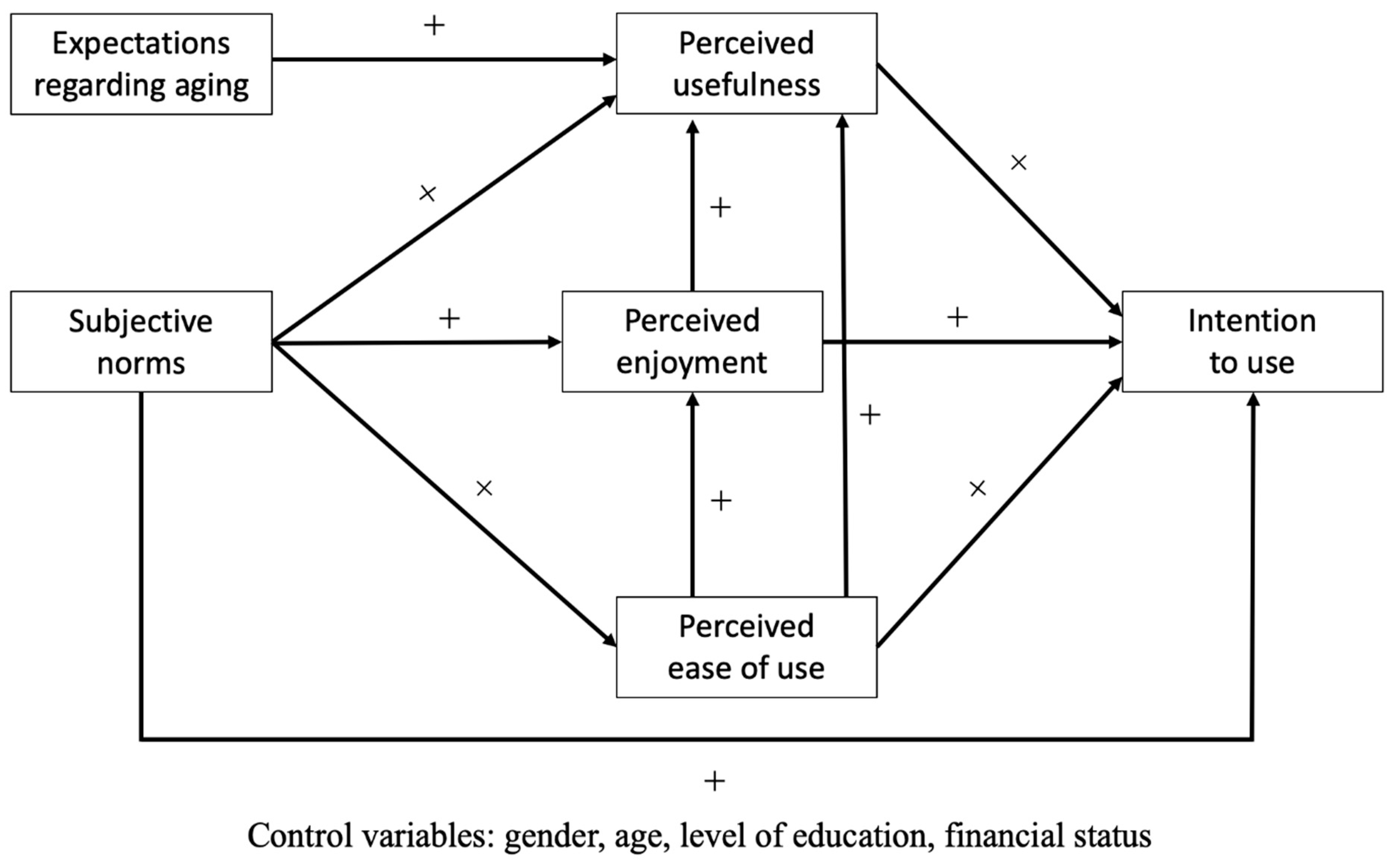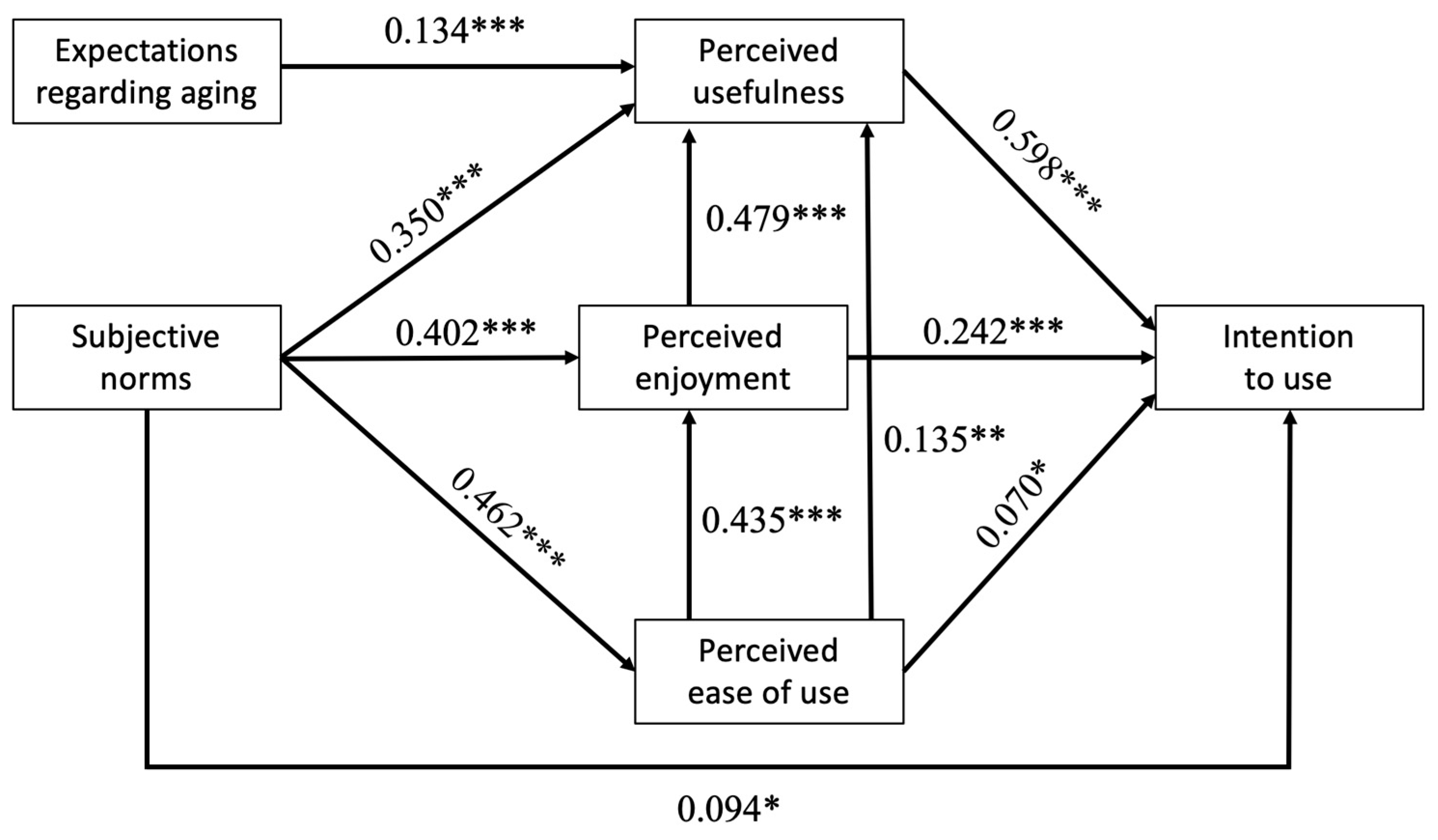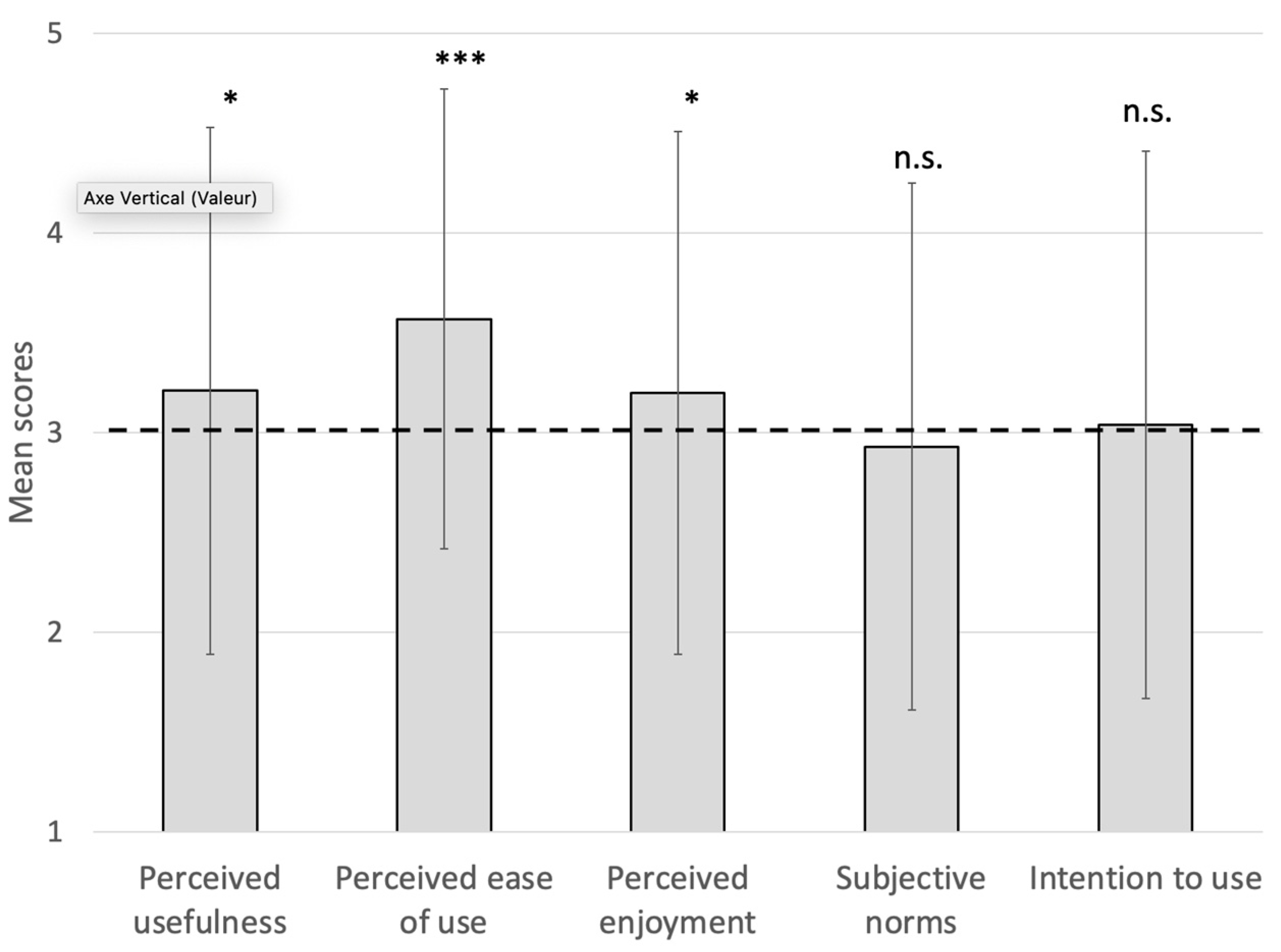Acceptance of a Mobile Telepresence Robot, before Use, to Remotely Supervise Older Adults’ Adapted Physical Activity
Abstract
:1. Introduction
1.1. Background
1.2. Technology Acceptance and MTR Acceptance
1.3. Objectives and Hypotheses of the Present Study
2. Methods
2.1. Participants and Procedure
2.2. Measures
2.3. Statistical Analyses
3. Results
3.1. Preliminary Results
3.2. Validation of the TAM
3.3. Levels of MTR Acceptance
4. Discussion
Current Limitations and Directions for Future Studies
5. Conclusions
Author Contributions
Funding
Institutional Review Board Statement
Informed Consent Statement
Data Availability Statement
Acknowledgments
Conflicts of Interest
References
- Berchicci, M.; Lucci, G.; Di Russo, F. Benefits of Physical Exercise on the Aging Brain: The Role of the Prefrontal Cortex. J. Gerontol. Ser. A 2013, 68, 1337–1341. [Google Scholar] [CrossRef]
- Cunningham, C.; O’Sullivan, R.; Caserotti, P.; Tully, M.A. Consequences of physical inactivity in older adults: A systematic review of reviews and meta-analyses. Scand. J. Med. Sci. Sports 2020, 30, 816–827. [Google Scholar] [CrossRef]
- Trost, S.G.; Owen, N.; Bauman, A.E.; Sallis, J.F.; Brown, W. Correlates of adults’ participation in physical activity: Review and update. Med. Sci. Sports Exerc. 2002, 34, 1996–2001. [Google Scholar] [CrossRef]
- World Health Organization. Continuity and Coordination of Care: A Practice Brief to Support Implementation of the WHO Framework on Integrated People-Centred Health Services; World Health Organization: Geneva, Switzerland, 2018. [Google Scholar]
- Langeard, A.; Bigot, L.; Maffiuletti, N.A.; Moussay, S.; Sesboüé, B.; Quarck, G.; Gauthier, A. Non-inferiority of a home-based videoconference physical training program in comparison with the same program administered face-to-face in healthy older adults: The MOTION randomised controlled trial. Age Ageing 2022, 51, afac059. [Google Scholar] [CrossRef]
- Schulz, R.; Wahl, H.-W.; Matthews, J.T.; Dabbs, A.D.V.; Beach, S.R.; Czaja, S.J. Advancing the Aging and Technology Agenda in Gerontology. Gerontologist 2014, 55, 724–734. [Google Scholar] [CrossRef]
- Wu, X.; Nix, L.C.; Brummett, A.M.; Aguillon, C.; Oltman, D.J.; Beer, J.M. The design, development, and evaluation of telepresence interfaces for aging adults: Investigating user perceptions of privacy and usability. Int. J. Hum.-Comput. Stud. 2021, 156, 102695. [Google Scholar] [CrossRef]
- Lei, M.; Clemente, I.M.; Liu, H.; Bell, J. The Acceptance of Telepresence Robots in Higher Education. Int. J. Soc. Robot. 2022, 14, 1025–1042. [Google Scholar] [CrossRef]
- Čaić, M.; Avelino, J.; Mahr, D.; Odekerken-Schröder, G.; Bernardino, A. Robotic Versus Human Coaches for Active Aging: An Automated Social Presence Perspective. Int. J. Soc. Robot. 2019, 12, 867–882. [Google Scholar] [CrossRef]
- Hayotte, M.; Thérouanne, P.; Gray, L.; Corrion, K.; D’Arripe-Longueville, F. The French eHealth Acceptability Scale Using the Unified Theory of Acceptance and Use of Technology 2 Model: Instrument Validation Study. J. Med. Internet Res. 2020, 22, e16520. [Google Scholar] [CrossRef]
- Mascret, N.; Montagne, G.; Devrièse-Sence, A.; Vu, A.; Kulpa, R. Acceptance by athletes of a virtual reality head-mounted display intended to enhance sport performance. Psychol. Sport Exerc. 2022, 61, 102201. [Google Scholar] [CrossRef]
- Davis, F.D. Perceived Usefulness, Perceived Ease of Use, and User Acceptance of Information Technology. MIS Q. 1989, 13, 319–340. [Google Scholar] [CrossRef]
- Venkatesh, V.; Bala, H. Technology Acceptance Model 3 and a Research Agenda on Interventions. Decis. Sci. 2008, 39, 273–315. [Google Scholar] [CrossRef]
- Venkatesh, V.; Davis, F.D. A Theoretical Extension of the Technology Acceptance Model: Four Longitudinal Field Studies. Manag. Sci. 2000, 46, 186–204. [Google Scholar] [CrossRef]
- Mascret, N.; Delbes, L.; Voron, A.; Temprado, J.-J.; Montagne, G. Acceptance of a Virtual Reality Headset Designed for Fall Prevention in Older Adults: Questionnaire Study. J. Med. Internet Res. 2020, 22, e20691. [Google Scholar] [CrossRef]
- Syed-Abdul, S.; Malwade, S.; Nursetyo, A.A.; Sood, M.; Bhatia, M.; Barsasella, D.; Liu, M.F.; Chang, C.-C.; Srinivasan, K.; Raja, M.; et al. Virtual reality among the elderly: A usefulness and acceptance study from Taiwan. BMC Geriatr. 2019, 19, 1–10. [Google Scholar] [CrossRef]
- Isabet, B.; Pino, M.; Lewis, M.; Benveniste, S.; Rigaud, A.-S. Social Telepresence Robots: A Narrative Review of Experiments Involving Older Adults before and during the COVID-19 Pandemic. Int. J. Environ. Res. Public Heal. 2021, 18, 3597. [Google Scholar] [CrossRef]
- Tsai, T.C.; Hsu, Y.L.; Ma, A.I.; King, T.; Wu, C.H. Developing a Telepresence Robot for Interpersonal Communication with the Elderly in a Home Environment. Telemed. e-Health 2007, 13, 407–424. [Google Scholar] [CrossRef]
- Koceski, S.; Koceska, N. Evaluation of an Assistive Telepresence Robot for Elderly Healthcare. J. Med Syst. 2016, 40, 1–7. [Google Scholar] [CrossRef]
- Mitzner, T.L.; Stuck, R.; Hartley, J.Q.; Beer, J.; Rogers, W.A. Acceptance of televideo technology by adults aging with a mobility impairment for health and wellness interventions. J. Rehabilitation Assist. Technol. Eng. 2017, 4, 2055668317692755. [Google Scholar] [CrossRef]
- Scherer, R.; Siddiq, F.; Tondeur, J. The technology acceptance model (TAM): A meta-analytic structural equation modeling approach to explaining teachers’ adoption of digital technology in education. Comput. Educ. 2018, 128, 13–35. [Google Scholar] [CrossRef]
- Sarkisian, C.A.; Steers, W.N.; Hays, R.D.; Mangione, C.M. Development of the 12-Item Expectations Regarding Aging Survey. Gerontol. 2005, 45, 240–248. [Google Scholar] [CrossRef]
- Sarkisian, C.A.; Prohaska, T.R.; Wong, M.D.; Hirsch, S.; Mangione, C.M. The relationship between expectations for aging and physical activity among older adults. J. Gen. Intern. Med. 2005, 20, 911–915. [Google Scholar] [CrossRef]
- Dogra, S.; Al-Sahab, B.; Manson, J.; Tamim, H. Aging Expectations are Associated With Physical Activity and Health Among Older Adults of Low Socioeconomic Status. J. Aging Phys. Act. 2015, 23, 180–186. [Google Scholar] [CrossRef]
- Meisner, B.A. A Meta-Analysis of Positive and Negative Age Stereotype Priming Effects on Behavior Among Older Adults. J. Gerontol. Ser. B 2011, 67, 13–17. [Google Scholar] [CrossRef]
- Koivisto, J.; Malik, A. Gamification for Older Adults: A Systematic Literature Review. Gerontol. 2020, 61, e360–e372. [Google Scholar] [CrossRef]
- Li, J.; Ma, Q.; Chan, A.H.; Man, S. Health monitoring through wearable technologies for older adults: Smart wearables acceptance model. Appl. Ergon. 2018, 75, 162–169. [Google Scholar] [CrossRef]
- Chen, T.L.; Bhattacharjee, T.; Beer, J.; Ting, L.H.; Hackney, M.E.; Rogers, W.A.; Kemp, C.C. Older adults’ acceptance of a robot for partner dance-based exercise. PLoS ONE 2017, 12, e0182736. [Google Scholar] [CrossRef]
- Dunn, T.J.; Baguley, T.; Brunsden, V. From alpha to omega: A practical solution to the pervasive problem of internal consistency estimation. Br. J. Psychol. 2013, 105, 399–412. [Google Scholar] [CrossRef]
- In’Nami, Y.; Koizumi, R. Review of Sample Size for Structural Equation Models in Second Language Testing and Learning Research: A Monte Carlo Approach. Int. J. Test. 2013, 13, 329–353. [Google Scholar] [CrossRef]
- Curran, P.J.; West, S.G.; Finch, J.F. The robustness of test statistics to nonnormality and specification error in confirmatory factor analysis. Psychol. Methods 1996, 1, 16–29. [Google Scholar] [CrossRef]
- Byrne, B.M. Structural Equation Modelling with AMOS: Basic Concepts, Applications, and Programming; Routledge: New York, NY, USA, 2010. [Google Scholar]
- Hu, L.T.; Bentler, P.M. Cutoff criteria for fit indexes in covariance structure analysis: Conventional criteria versus new alternatives. Struct. Equ. Model. Multidiscip. J. 1999, 6, 1–55. [Google Scholar] [CrossRef]
- Everitt, B.; Hothorn, T. An Introduction to Applied Multivariate Analysis with R.; Springer Science & Business Media: Berlin/Heidelberg, Germany, 2011. [Google Scholar]
- Zigarmi, D.; Galloway, F.J.; Roberts, T.P. Work Locus of Control, Motivational Regulation, Employee Work Passion, and Work Intentions: An Empirical Investigation of an Appraisal Model. J. Happiness Stud. 2016, 19, 231–256. [Google Scholar] [CrossRef]
- Peek, S.T.M.; Luijkx, K.G.; Vrijhoef, H.J.M.; Nieboer, M.E.; Aarts, S.; Van Der Voort, C.S.; Rijnaard, M.D.; Wouters, E.J.M. Understanding changes and stability in the long-term use of technologies by seniors who are aging in place: A dynamical framework. BMC Geriatr. 2019, 19, 1–13. [Google Scholar] [CrossRef]
- Van der Heijden, H. User Acceptance of Hedonic Information Systems. MIS Q. 2004, 28, 695. [Google Scholar] [CrossRef]
- Bruner, G.C.; Kumar, A. Explaining consumer acceptance of handheld Internet devices. J. Bus. Res. 2005, 58, 553–558. [Google Scholar] [CrossRef]
- Lee, L.Y.; Lim, W.M.; Teh, P.L.; Malik, O.A.S.; Nurzaman, S. Understanding the interaction between older adults and soft service robots: Insights from robotics and the technology acceptance model. AIS Trans. Hum.-Comput. Interact. 2020, 12, 125–145. [Google Scholar] [CrossRef]
- Chen, K.; Chan, A.H.S. Gerontechnology acceptance by elderly Hong Kong Chinese: A senior technology acceptance model (STAM). Ergonomics 2014, 57, 635–652. [Google Scholar] [CrossRef]
- Phillips, D.L.; Clancy, K.J. Some Effects of "Social Desirability" in Survey Studies. Am. J. Sociol. 1972, 77, 921–940. [Google Scholar] [CrossRef]
- Venkatesh, V.; Thong, J.Y.L.; Xu, X. Consumer Acceptance and Use of Information Technology: Extending the Unified Theory of Acceptance and Use of Technology. MIS Q. 2012, 36, 157–178. [Google Scholar] [CrossRef]
- Mackay, H.; Gillespie, G. Extending the Social Shaping of Technology Approach: Ideology and Appropriation. Soc. Stud. Sci. 1992, 22, 685–716. [Google Scholar] [CrossRef]



| Perceived Usefulness | Perceived Ease of Use | Perceived Enjoyment | Subjective Norms | Intention to Use | ERA | |
|---|---|---|---|---|---|---|
| Mean | 3.21 | 3.57 | 3.20 | 2.93 | 3.04 | 51.40 |
| Standard deviation | 1.32 | 1.15 | 1.31 | 1.32 | 1.37 | 17.60 |
| Skewness | −0.27 | −0.62 | −0.22 | −0.24 | −0.08 | −0.38 |
| Kurtosis | −1.14 | −0.50 | −1.06 | −1.09 | −1.28 | 0.62 |
| McDonald’s omega | 0.93 | 0.90 | 0.93 | 0.94 | 0.96 | 0.88 |
Disclaimer/Publisher’s Note: The statements, opinions and data contained in all publications are solely those of the individual author(s) and contributor(s) and not of MDPI and/or the editor(s). MDPI and/or the editor(s) disclaim responsibility for any injury to people or property resulting from any ideas, methods, instructions or products referred to in the content. |
© 2023 by the authors. Licensee MDPI, Basel, Switzerland. This article is an open access article distributed under the terms and conditions of the Creative Commons Attribution (CC BY) license (https://creativecommons.org/licenses/by/4.0/).
Share and Cite
Mascret, N.; Temprado, J.-J. Acceptance of a Mobile Telepresence Robot, before Use, to Remotely Supervise Older Adults’ Adapted Physical Activity. Int. J. Environ. Res. Public Health 2023, 20, 3012. https://doi.org/10.3390/ijerph20043012
Mascret N, Temprado J-J. Acceptance of a Mobile Telepresence Robot, before Use, to Remotely Supervise Older Adults’ Adapted Physical Activity. International Journal of Environmental Research and Public Health. 2023; 20(4):3012. https://doi.org/10.3390/ijerph20043012
Chicago/Turabian StyleMascret, Nicolas, and Jean-Jacques Temprado. 2023. "Acceptance of a Mobile Telepresence Robot, before Use, to Remotely Supervise Older Adults’ Adapted Physical Activity" International Journal of Environmental Research and Public Health 20, no. 4: 3012. https://doi.org/10.3390/ijerph20043012
APA StyleMascret, N., & Temprado, J.-J. (2023). Acceptance of a Mobile Telepresence Robot, before Use, to Remotely Supervise Older Adults’ Adapted Physical Activity. International Journal of Environmental Research and Public Health, 20(4), 3012. https://doi.org/10.3390/ijerph20043012






